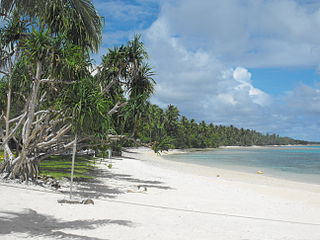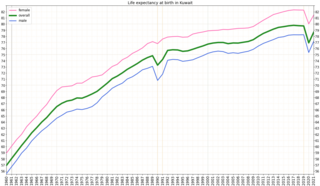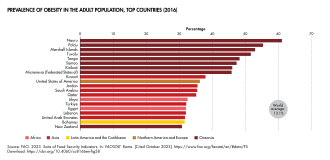
The Marshall Islands, officially the Republic of the Marshall Islands, is an island country west of the International Date Line and north of the equator in the Micronesia region in the Northwestern Pacific Ocean. The territory consists of 29 coral atolls and five islands, divided across two island chains: Ratak in the east and Ralik in the west. 97.87% of its territory is water, the largest proportion of water to land of any sovereign state. The country shares maritime boundaries with Wake Island to the north, Kiribati to the southeast, Nauru to the south, and the Federated States of Micronesia to the west. The capital and largest city is Majuro, home to approximately half of the country's population.

Majuro is the capital and largest city of the Marshall Islands. It is also a large coral atoll of 64 islands in the Pacific Ocean. It forms a legislative district of the Ratak (Sunrise) Chain of the Marshall Islands. The atoll has a land area of 9.7 square kilometers (3.7 sq mi) and encloses a lagoon of 295 square kilometers (114 sq mi). As with other atolls in the Marshall Islands, Majuro consists of narrow land masses. It has a tropical trade wind climate, with an average temperature of 27 °C (81 °F).

Bikini Atoll, known as Eschscholtz Atoll between the 19th century and 1946, is a coral reef in the Marshall Islands consisting of 23 islands surrounding a 229.4-square-mile (594.1 km2) central lagoon. The atoll is at the northern end of the Ralik Chain, approximately 530 miles (850 km) northwest of the capital Majuro.

Enewetak Atoll is a large coral atoll of 40 islands in the Pacific Ocean and with its 296 people forms a legislative district of the Ralik Chain of the Marshall Islands. With a land area total less than 5.85 square kilometers (2.26 sq mi), it is no higher than 5 meters (16.4 ft) and surrounds a deep central lagoon, 80 kilometers (50 mi) in circumference. It is the second-westernmost atoll of the Ralik Chain and is 305 kilometers (190 mi) west from Bikini Atoll.

This is a list of hospitals in Oceania for each sovereign state, associated states of New Zealand, and dependencies, and territories. Links to lists of hospitals in countries are used when there are more than a few hospitals in the country. Oceania has an area of 8,525,989 km2 and population of 41,570,842 (2018). The World Health Organization surveys of healthcare in smaller countries are used to identify hospitals in smaller countries.

The Compacts of Free Association (COFA) are international agreements establishing and governing the relationships of free association between the United States and the three Pacific Island sovereign states of the Federated States of Micronesia (FSM), the Republic of the Marshall Islands (RMI), and the Republic of Palau. As a result, these countries are sometimes known as the Freely Associated States (FASs). All three agreements next expire in 2043.

Kili Island or Kili Atoll is a small, 81 hectares island located in the Marshall Islands in the Pacific Ocean. As of 2021, 415 people lived on the island, many of whom were descended from islanders who originally lived on Bikini Atoll. They were relocated when they agreed to let the U.S. government temporarily use their home for nuclear testing in 1945. Kili Island became their home after two prior relocations failed. The island does not have a natural lagoon and cannot produce enough food to enable the islanders to be self-sufficient. It is part of the legislative district of the Ralik Chain of the Marshall Islands. The island is approximately 48 kilometers (30 mi) southwest of Jaluit. It is a good sized island for the Marshall Islands, but it is not an atoll with a lagoon.

Diseases of affluence, previously called diseases of rich people, is a term sometimes given to selected diseases and other health conditions which are commonly thought to be a result of increasing wealth in a society. Also referred to as the "Western disease" paradigm, these diseases are in contrast to "diseases of poverty", which largely result from and contribute to human impoverishment. These diseases of affluence have vastly increased in prevalence since the end of World War II.

Guraidhoo is one of the inhabited islands of Thaa Atoll, Maldives.

The major causes of deaths in Finland are cardiovascular diseases, malignant tumors, dementia and Alzheimer's disease, respiratory diseases, alcohol related diseases and accidental poisoning by alcohol. In 2010, the leading causes of death among men aged 15 to 64 were alcohol related deaths, ischaemic heart disease, accident, suicides, lung cancer and cerebrovascular diseases. Among women the leading causes were breast cancer, alcohol related deaths, accidents, suicides, ischaemic heart disease and lung cancer.

In Kuwait, life expectancy at birth in 2013 was 78 for men and 79 for women.
The health status of Namibia has increased steadily since independence, and the government does have focus on health in the country and seeks to make health service upgrades. As a guidance to achieve this goal, the Institute for Health Metrics and Evaluation (IHME) and World Health Organization (WHO) recently published the report "Namibia: State of the Nation's Health: Findings from the Global Burden of Disease." The report backs the fact that Namibia has made steady progress in the last decades when it comes to general health and communicable diseases, but despite this progress, HIV/AIDS still is the major reason for low life expectancy in the country.

Brunei's healthcare system is managed by the Brunei Ministry of Health and funded by the General Treasury. It consists of around 15 health centers, ten clinics and 22 maternal facilities, considered to be of reasonable standard. There are also two private hospitals. Cardiovascular disease, cancer, and diabetes are the leading cause of death in the country, with life expectancy around 75 years, a vast improvement from 1961. Brunei's human development index (HCI) improved from 0.81 in 2002 to 0.83 in 2021, expanding at an average annual rate of 0.14%. According to the UN's Human Development Report 2020, the HCI for girls in the country is greater than for boys, though aren't enough statistics in Brunei to break down HCI by socioeconomic classes. Brunei is the second country in Southeast Asia after Singapore to be rated 47th out of 189 nations on the UN HDI 2019 and has maintained its position in the Very High Human Development category. Being a culturally taboo subject, the rate of suicide has not been investigated.

Women in Tuvalu continue to maintain a traditional Polynesian culture within a predominantly Christian society. Tuvaluan cultural identity is sustained through an individual's connection to their home island. In the traditional community system in Tuvalu, each family has its own task, or salanga, to perform for the community. The skills of a family are passed on from parents to children. The women of Tuvalu participate in the traditional music of Tuvalu and in the creation of the art of Tuvalu including using cowrie and other shells in traditional handicrafts. There are opportunities of further education and paid employment with non-government organisations (NGOs) and government enterprises, education and health agencies being the primary opportunities for Tuvaluan women.

Nuclear testing at Bikini Atoll consisted of the detonation of 24 nuclear weapons by the United States between 1946 and 1958 on Bikini Atoll in the Marshall Islands. Tests occurred at 7 test sites on the reef itself, on the sea, in the air, and underwater. The test weapons produced a combined yield of about 75 Mt of TNT in explosive power. After the inhabitants agreed to a temporary evacuation, two nuclear weapons were detonated in 1946. About ten years later, additional tests with thermonuclear weapons in the late 1950s were also conducted. The first thermonuclear explosion was much more powerful than expected, and created a number of issues, but did demonstrate the dangers of such devices.

Hospitals and small medical centers and posts are found throughout the island of Madagascar, although they are concentrated in urban areas and particularly in Antananarivo. In addition to the high expense of medical care relative to the average Malagasy income, the prevalence of trained medical professionals remains extremely low.

Delap-Uliga-Djarrit is an urban area in Majuro, the capital and the largest city of the Marshall Islands, with 15,846 people out of Majuro's 23,676. It consists of the districts of Delap, Uliga, and Djarrit. DUD is located on the eastern end of Majuro Atoll. Marshallese government buildings are situated in DUD.
Montenegro is a country with an area of 13,812 square kilometres and a population of 620,029, according to the 2011 census. The country is bordered by Croatia, the Adriatic Sea, Bosnia, Herzegovina, Serbia, Kosovo and Albania. The most common health issues faced are non-communicable diseases accounting for 95% of all deaths. This is followed by 4% of mortality due to injury, and 1% due to communicable, maternal, perinatal and nutritional conditions. Other health areas of interest are alcohol consumption, which is the most prevalent disease of addiction within Montenegro and smoking. Montenegro has one of the highest tobacco usage rates across Europe. Life expectancy for men is 74 years, and life expectancy for women is 79.
As in much of Oceania, obesity is a major health issue in Tuvalu with 65% of men and 71% of women being overweight. In 2012 the birth rate on the islands was estimated at 23 per 1,000 people and life expectancy was 65.
There is a population of Marshallese people in Northwest Arkansas, concentrated in Springdale.
















